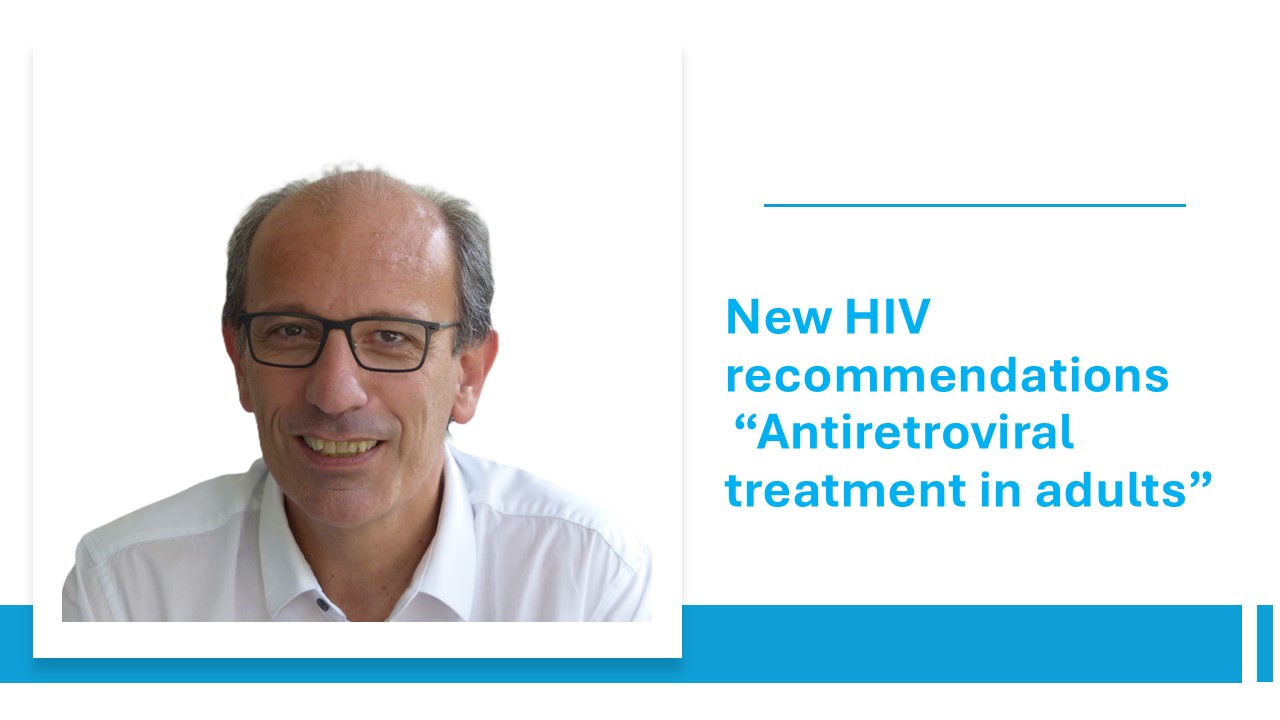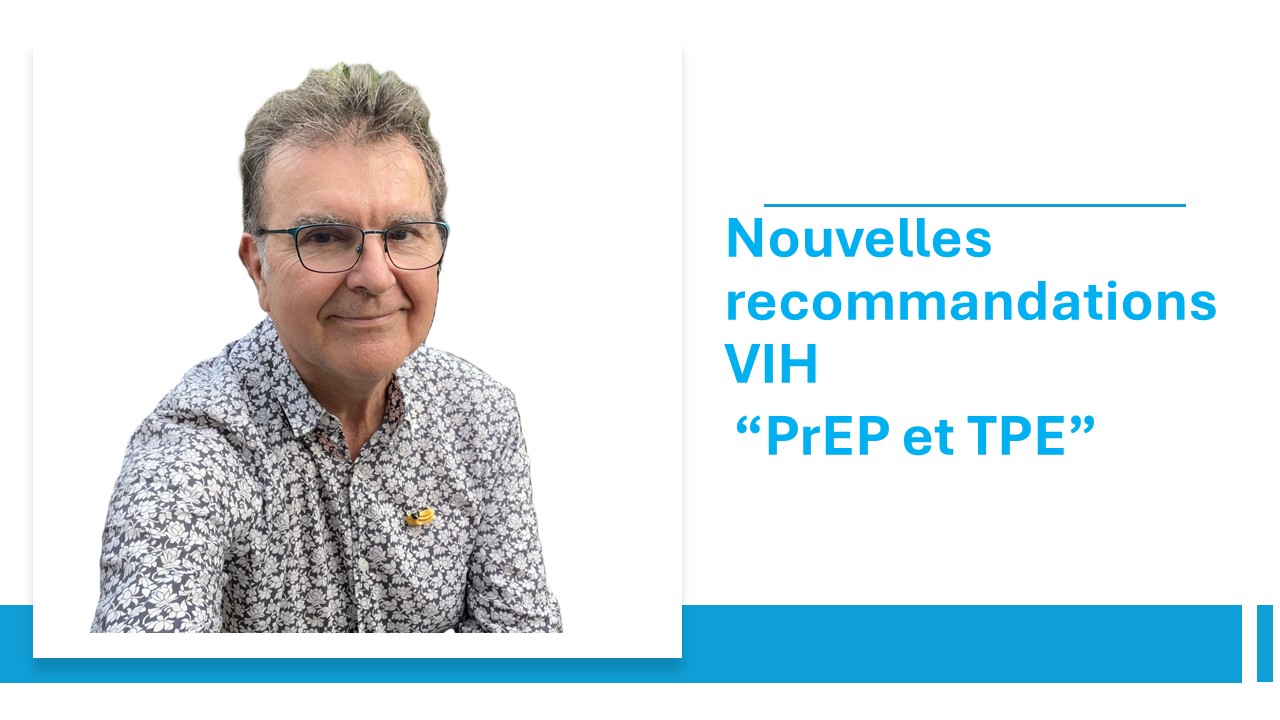
Interview with Pr André Cabié on the new HIV treatment recommendations
Interview with Professor André Cabié, Martinique University Hospital, France
Last updated on 18 October 2024
The essential
Three new chapters of recommendations were published online in October 2024. The work is being carried out under the aegis of the ANRS MIE, the Conseil National du Sida et des hépatites virales (CNS), and the Haute Autorité de santé ( HAS). In an interview, Professor André Cabié, who is leading the working group, outlined the key aspects of these chapters, which cover the initiation of initial antiretroviral treatment and the adaptation of treatment in the event of virological success or failure.
What are the main changes in the recommendations concerning the initiation of initial antiretroviral treatment in adults living with HIV?
The new recommendations are more specific about the time frame for initiating antiretroviral treatment in asymptomatic people. In previous recommendations or in the current recommendations of other countries and international bodies, this period is not defined.
It is now recommended that treatment be started within two weeks of diagnosis, during a specialist consultation. There are, however, specific situations in which treatment may be delayed, such as in people with HIV-2, HIV-1 controllers, or those who are not ready to start immediately.
On the other hand, certain situations require immediate treatment, such as in cases of primary infection or pregnancy in the third trimester. On the other hand, if a well-informed patient requests it, or if there is a high risk of HIV transmission, treatment can be started as early as the first consultation.
Another change concerns the initial assessment: the recommendations now specify which elements are essential for starting treatment and which can be completed in the following days or weeks. For example, obtaining the result of the genotypic resistance test should not delay initiation of treatment.
The recommended initial treatment is a combination of 2- or 3-drugs regimen (dual or triple therapy) for HIV-1, and 3-drugs regimen for HIV-2. The choice of a single-tablet regimen is preferred. Four main options are proposed: 2- or 3-drugs regimen with an integrase strand transfer inhibitor or 3-drugs regimen with a non-nucleoside reverse transcriptase inhibitor.
Finally, the recommendations concerning the initiation of treatment for opportunistic infections have been simplified. Treatment is generally started within 14 days of diagnosis of the infection, except in two specific cases: neuro-meningeal tuberculosis and neuro-meningeal cryptococcal infection, where a delay is necessary.
This pragmatic approach, with its precise 14-day timeframe, is quite innovative compared with European and American recommendations, where the timeframe for initiating treatment is less precisely defined
How do these new recommendations contribute to the goal of eliminating HIV transmission by 2030?
The principle is simple: the faster we treat, the more effectively we can interrupt transmission. In France, data from the Dat’AIDS cohort[1] show a reduction in the time between first treatment and first antiretroviral treatment, from 67 days in 2009-2011 to 13 days in 2018-2019. The latest report, “Indicateurs de prise en charge des PVVIH dans les COREVIH en France en 2022[2] “, also shows that, depending on the region, between 50% and 75% of new patients are treated in less than 15 days. Treating all people living with HIV, and doing it quickly, is the best strategy for achieving the goal of eliminating transmission by 2030.
[1] Cuzin L, et al. Drastic Reduction in Time to Controlled Viral Load in People With Human Immunodeficiency Virus in France, 2009-2019: A Longitudinal Cohort Study. Clin Infect Dis. 2024;78(1):111-117.
[2] Report on indicators of care for PLHIV in COREVIHs in France in 2022. https://anrs-co4.fhdh.fr/rapports-des-indicateurs-de-prise-en-charge-des-pvvih-dans-les-corevih-en-france/
In a situation of virological success, what adaptations to antiretroviral treatment are possible, with what benefits for the patient?
With more data available, we now have many options for reducing and simplifying treatment. There are three main recommended strategies:
- switch to dual oral therapy
- switch to long-acting dual injectable therapy (with one injection every two months).
These dual therapies make it possible to reduce the number of drugs used, thereby lightening the drug load and simplifying daily administration.
- or opt for intermittent triple therapy (four or five days a week). This approach, supported by the ANRS Quatuor trial[1] , significantly reduces drug exposure, potentially reducing long-term toxicity, while maintaining treatment efficacy.
These adjustments offer a number of benefits: they make it easier to take the drugs, thereby improving compliance, and they reduce exposure to the drugs, thereby limiting long-term toxicity. It is essential to observe contraindications and special precautions before modifying treatment (history of failure or resistance, co-infection with HBV, etc.).
[1] Landman R, et al. A 4-days-on and 3-days-off maintenance treatment strategy for adults with HIV-1 (ANRS 170 QUATUOR): a randomised, open-label, multicentre, parallel, non-inferiority trial. Lancet HIV. 2022;9(2):e79-e90.
In the event of virological failure, what treatment strategies are now preferred?
Virological failures with resistance are now rare and are most often linked to compliance problems. Unlike in the past, when it was difficult to control the situation, we now have effective treatments. In the event of failure, we rebuild a strategy with two or three active drugs. For patients suffering from multi-drug resistance, three new compounds are available: fostemsavir, lenacapavir and ibalizumab, reserved for multi-failure situations.
How do these new recommendations take into account recent advances in research and the new antiretroviral drugs available on the market?
: Current recommendations are based on controlled clinical trials, which guarantee a sufficient level of evidence before they are adopted. A number of new molecules are being developed, in particular injectable treatments that could be administered even further apart. At the moment, we have long-acting injectable treatments every two months, but lenacapavir, for example, could allow injections every six months.
It is also very clear that people living with HIV appreciate these new options, as they free them from the constraints of taking daily medication.
What is the common objective of these 3 chapters?
What the three chapters of the recommendations have in common is that, whatever the context, antiretroviral treatment must achieve effective control of viral replication. This fundamental principle translates into several benefits: the absence of HIV-related morbidity, the prevention of transmission, and a better health-related quality of life for people living with HIV.
Whether the treatment is initiated, maintained by adapting the dose to simplify or lighten the protocols, or in the event of virological failure, the objective remains the same: to control viral replication. Thanks to the treatments available, including the new compounds, this objective can be achieved in virtually all situations. Permanent virological control is also at the heart of the strategy aimed at eliminating HIV transmission by 2030.
Whether in initiation, maintenance or management of failures, the new recommendations all aim for optimal control of viral replication, which is essential if we are to achieve the goal of eliminating HIV by 2030


